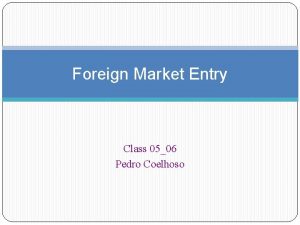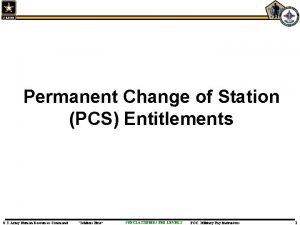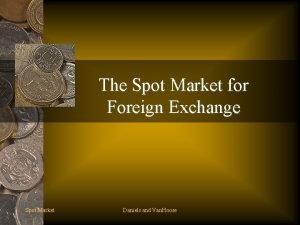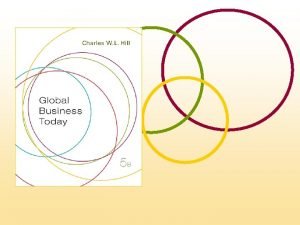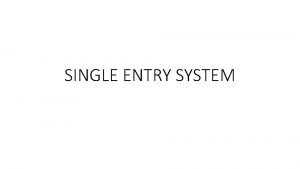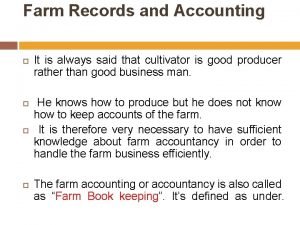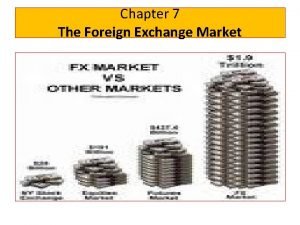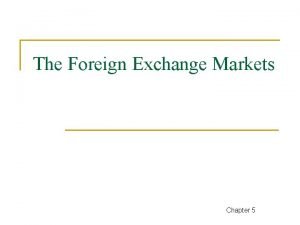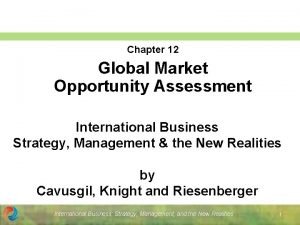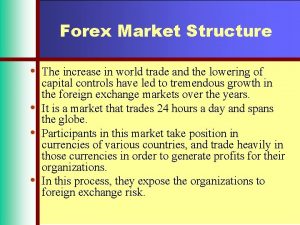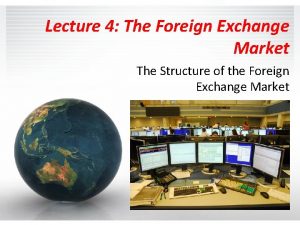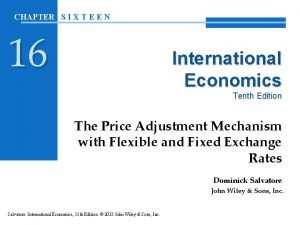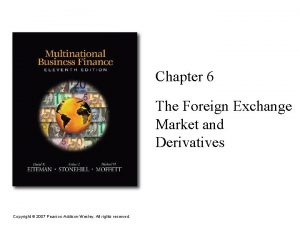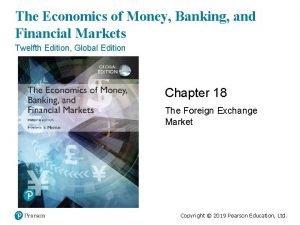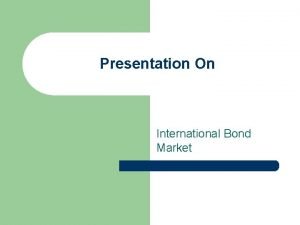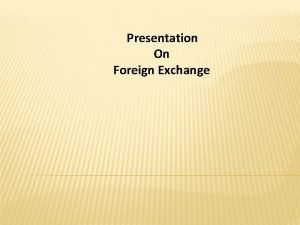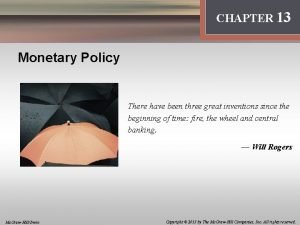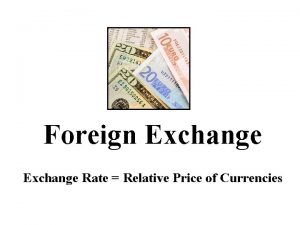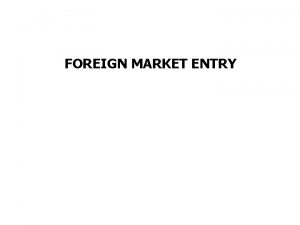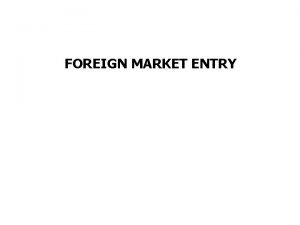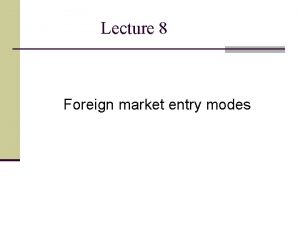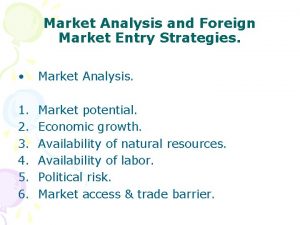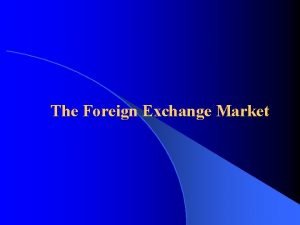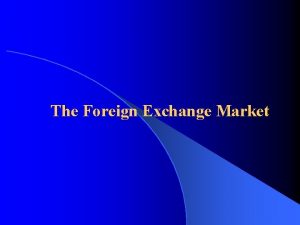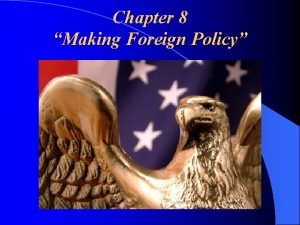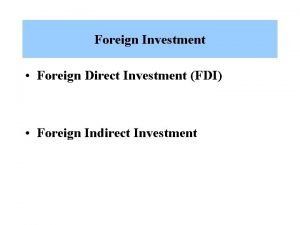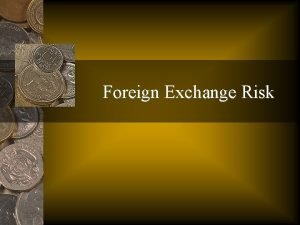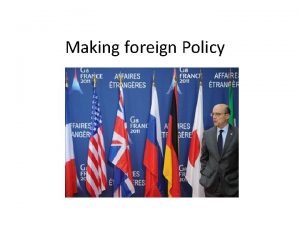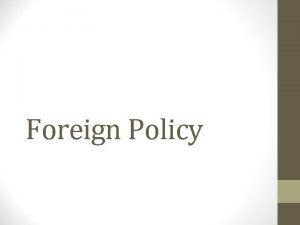Foreign Market Entry Class 0506 Pedro Coelhoso Thoughts
























- Slides: 24

Foreign Market Entry Class 05_06 Pedro Coelhoso

Thoughts for the Day All our social problems arise from doing the wrong things righter. The more efficient you are at doing the wrong thing, the wronger you become. It is much better to do the right thing wronger than the wrong thing righter. If you do the right thing wronger and correct it, you get better. Russell Ackoff (1919 -2009)

Outline for Today Administrative Announcements More on the link between strategy and institutions Where are we in the course? Foreign Country Entry Why go abroad? Why and Where to enter? Why and Where and How to enter? Main Points and Implications Set-up for next class

Strategy and Institutions Khanna T, Palepu K. 1997. “Why focused strategies may be wrong for emerging markets”. Harvard Business Review, 75(4): 41 -51. They argue that focused strategies may be wrong for emerging markets as the required institutions may not be present to support this western-world mindset. They suggest that “companies must adapt their strategies to fit their institutional context”.

Applying Perspectives on International Strategy These impact how firms behave. Industry-based Competition Firm-specific Resources & capabilities Institutional Conditions: - Formal - Informal Acquisitions/Restructuring Global Competitive Dynamics Entering Foreign Mkts Country Selection Local Competition Locating activities across countries Structure Strategic Decisions International Strategy Implementation/ Performance Learning/Alliances

Changes in National Regulations of Foreign Direct Investment (FDI), 1991– 2002 Source: United Nations, 2003, World Investment Report 2003 (p. 13), New York and Geneva: United Nations. WSJ: September 15, 2009 Update: Sept 2009: 130 protectionist measures planned For 2009, 90% of goods affected by protectionist measures Ratio of discriminatory vs. liberalizing trade laws is 6: 1. Most targeted countries: China, U. S. , Japan

Why Go Abroad? Answers traditionally include: More customers: Economies of scale Economies of scope. Reduce the dependence on one country. To replicate the success at home in new settings. Possibly: The answer can be “all of the above”

Why NOT go abroad: Overcoming the Liability of Foreignness The inherent disadvantage foreign firms experience in host countries because of their non-native status. Liability can be seen in two dimensions: Differences in formal and informal institutions in different countries (e. g. , regulatory, language, and cultural differences). Customers discriminate against foreign firms, sometimes formally and other times informally.

Why NOT go abroad? Overcoming the Liability of Foreignness To offset the liability of foreignness, foreign firms must employ overwhelming resources and capabilities: Superior knowledge about institutions for that market Volkswagen in China and CEE Superior technologies for that market Australian warship named Joint Venture Superior organizational, marketing, and financial capabilities for that market WARNING: Not every firm is ready for going abroad.

INTERNATIONALIZATION: GO or NO GO Figure 6. 1

A Comprehensive Model of Foreign Market Entries Figure 6. 2

(Why and) Where to Enter? Location-Specific Advantages Geographical features difficult to match by others. Singapore, Austria, Turkey, Miami Clustering of economic activities (agglomeration). Knowledge spillover among closely located firms that attempt to hire individuals from competitors. A regional skilled labor force available to work for different firms. A regional pool of specialized suppliers and buyers.

Why and Where to Enter? Location-Specific Advantages (cont’d) Why Where Source: First two columns adapted from J. Dunning, 1993, Multinational Enterprises and the Global Economy (pp. 82– 83), Reading, MA: Addison-Wesley. Table 6. 2

Where to Enter? Cultural/Institutional Distances and Foreign Entry Locations Cultural Distance The difference between two cultures along some identifiable dimensions (such as power distance). Institutional Distance (besides culture) The extent of similarity or dissimilarity between the regulatory, normative, and cognitive institutions of two countries. Firms from common-law countries are more likely to be interested in other common-law countries Colony-colonizer links boost trade by 900%

Why and Where to Enter? Cultural/Institutional Distances and Foreign Entry Locations (cont’d) Two schools of thought have emerged: Stage models: Enter culturally similar countries during the first stage of internationalization and, as they gain confidence, enter culturally more distant countries in later stages. Strategic Model: Considerations of strategic goals such as market and efficiency are more important than cultural/institutional considerations as suggested by stage models.

The Choice of Entry Modes: A Hierarchical Model Source: Adapted from Y. Pan & D. Tse, 2000, The hierarchical model of market entry modes (p. 538), Journal of International Business Studies, 31: 535– 554. Figure 6. 3

How to Enter? Scale of Entry: Commitment and Experience Large-Scale Entries Benefit from a strategic commitment Drawbacks of large-scale entries: Limited strategic flexibility and potential huge losses Small-scale entries Focus on accumulating experience “Learning by doing” Drawbacks of small-scale entries A lack of strong strategic commitment Difficulties in building market share Copyright © 2009 Cengage. All rights reserved. 6– 17

Risk / Return of International Market Entry Modes RETURN Joint Ventures Licensing Exporting Wholly Owned Subsidiary Franchising RISK

Modes of Entry: Advantages and Disadvantages Table 6. 4

Modes of Entry: Advantages and Disadvantages Table 6. 4 (cont’d)

Modes of Entry: Advantages and Disadvantages Table 6. 4 (cont’d)

Why and Where and How to Enter? Making Strategic Choices A company may have a variety of entry choices for different countries and tasks. Entry strategies may change over time. Starbucks: Franchising JV WOS China’s Haier in the United States: Direct exports FDI (green-field projects) Liability versus Asset of Foreignness Cyberspace Entry vs Conventional Entry: Rules to Use? Global versus Regional Triad Concentration

Main Points and Implications Foreign entry is the foundation for international business. Competing considerations: Industry level, Firm level, and Institutional level. Competing considerations for where to enter: natural resource, market, efficiency, and innovation seeking. Selection between options (trade-offs) will depend on goals and risk acceptance regarding mode of entry. Entry strategies, even when successful, do not guarantee international success. They are just the beginning. The challenge is to simplify and prioritize.

Set-Up for Next Class (Dec 17) Strategic Alliances and Acquisitions Reading: Peng Text, Chapters 7; Franchising Other Preparation: Read series of articles on Danone in China. Prepare a 4 -5 page analysis of the situation using the questions provided. Learning Objectives: We will learn about an increasingly important arrangement between firms that is more formal than a contract but does not involve buying another firm with some comparison to acquisitions.
 Hierarchical entry mode
Hierarchical entry mode Pedro coelhoso
Pedro coelhoso Permanent change of station regulation
Permanent change of station regulation Spot market in foreign exchange market
Spot market in foreign exchange market I am not my thoughts
I am not my thoughts Too foreign for home too foreign for here
Too foreign for home too foreign for here When entering foreign markets basic entry
When entering foreign markets basic entry Leader challenger
Leader challenger Positioning segmentation targeting
Positioning segmentation targeting Disadvantages of single entry system
Disadvantages of single entry system What is new entry
What is new entry Farm records and accounts
Farm records and accounts Kinds of foreign exchange market
Kinds of foreign exchange market Objective of foreign exchange market
Objective of foreign exchange market International market opportunity analysis
International market opportunity analysis Market structure forex
Market structure forex Structure of foreign exchange market
Structure of foreign exchange market Foreign exchange market features
Foreign exchange market features Stability of foreign exchange market
Stability of foreign exchange market Foreign exchange market example
Foreign exchange market example Equilibrium exchange rate graph
Equilibrium exchange rate graph International bond market
International bond market Exchange rate presentation
Exchange rate presentation Foreign exchange graph
Foreign exchange graph Exchange market graph
Exchange market graph
